Portable Oil Analysis Tools Reduce Routine Maintenance Costs
What do a power plant, a hospital, a police station, and a remote mine have in common? They all have essential assets requiring uninterruptible power, commonly powered by an engine generator as primary or backup power. Engine generators, often termed “gensets,” combine an electrical generator and an engine. They supply electrical power where normal utility power is not readily available or is unstable. Gensets are used for temporary power demands and are often mounted on trailers or transportable skids.
Unlike large facilities that typically have on-site central oil analysis labs, smaller, temporary, and backup generation has traditionally depended on preventive, time-based oil maintenance. However, now, portable, handheld oil analysis tools are widely available and can be used to extend oil drain intervals and reduce routine costs for these generation assets. These tools are getting a boost with the recently amended U.S. Environmental Protection Agency (EPA) National Emission Standards for Hazardous Air Pollutants (NESHAP) rules for emergency backup gensets. The new rules allow condition-based oil drain intervals, so asset owners can realize the benefits of oil analysis. This article outlines the challenges and solutions available to portable/emergency genset owners who have previously incurred the cost of time-based oil changes.
Routine Maintenance and Oil Condition
Some of the main operating costs of running and maintaining large engine generators are the material and labor costs associated with changing oil based on a fixed operating time interval. This routine is often recommended by the engine manufacturer and increasingly by local regulations aimed at curbing emissions. Oil changes are suggested based on operating hour or calendar-based intervals, regardless of whether the generator has been running at full load or is idle for most of the time. Until now, this task was nonnegotiable, especially if the genset was under warranty. The U.S. EPA actually mandates oil changes for stationary engines used for emergency backup power.
Here are some issues with scheduled oil changes that trouble engine owners:
■ Good oil gets changed unnecessarily. Not all generators run at the same load; therefore, it is likely that an oil change is unnecessary for some generators at the recommended change interval. This causes increased operating expense and waste, including material, labor, service engineer utilization, efficiency, as well as recycling cost. If an oil change interval can be extended for generators, the cost savings can be significant.
■ Scheduled oil changes will not solve an ongoing contamination problem. Engine damage due to contamination of the lubricant can continue, and usually increases in severity.
■ Catastrophic failures can still happen, and the cost of repair and downtime is not insignificant, even though it might be infrequent.
The Role of Oil Analysis
Forward-thinking genset owners and service providers have recognized these issues for some time, and they employ off-site or on-site oil analysis to determine the lubricant and equipment condition. In turn, they can determine if the oil can be extended or if the genset requires an overhaul.
The U.S. EPA has now acknowledged the benefits of condition-based oil changes founded on oil analysis results. The agency recently amended its regulations for stationary generators in emergency or backup mode to allow for extended changes if oil condition condemnation limits are not exceeded (Table 1).
 |
| Table 1. Time’s up! These are the new condemnation limits for in-service oil. Source: U.S. Environmental Protection Agency |
The rule specifically states that condemned oil must be changed within two days of the engine owner receiving information that oil has exceeded any of the specified limits. If oil condition is examined at the time of scheduled service, a decision can immediately be made as to whether the oil needs to be changed or if minor repairs are needed. This approach reduces both operation and maintenance costs, and the engine runs longer.
A similar situation can occur in managing an automotive fleet. Time-based oil change has been proven to generate additional waste due to unnecessary oil changes. Though the cost savings are real and the marketplace is starting to support them, the question is why condition-based oil changes aren’t a popular practice.
One reason is that the investment in a dedicated laboratory is not always practical. In mining operations and large power generation plants, it is common to have central oil analysis labs located on-site to continuously monitor the oil and machine condition of equipment. Decisions about oil change and other maintenance activities are made based on the recommendation of experienced laboratory data analysts.
While this is a very good industrial practice, it is difficult to apply this practice in the case of engine generator fleets because of the large, upfront capital investment, as well as the need to hire laboratory technicians and data analysts. Even if a central laboratory is established, the distributed or temporary nature of the gensets prevents service engineers from making immediate decisions due to the delay in getting results from the central lab. This is the problem with relying on contract labs to perform such work.
Another reason is that previous technologies for on-site oil analysis are insufficient to implement an effective condition-based oil change practice. The tools used to monitor oil condition need to meet the following requirements:
■ Easy to use. There’s no need to hire an experienced oil expert.
■ Portable. Maintenance engineers can carry it from one generator to another.
■ Fast. Engineers can use their on-site time more efficiently.
■ No waste stream and no recycling of hazardous material chemicals. This minimizes the cost of training to handle, store, transport, and recycle chemicals.
■ Comprehensive. The tool should capture the complete picture of oil condition with minimal chance of false alarms.
■ Repeatable and definitive. Decisions can be easily made.
■ Cost-effective. Return on investment is one or two years.
As you can see, this is not an easy list of requirements. There are many tools on the market that can partially meet them. The tools may be simple and easy to use, but not definitive, or they may be accurate, but expensive, difficult to use, or hard to deploy in the field.
Recently, Spectro Scientific introduced a comprehensive set of portable oil condition analyzers that provide a complete picture of in-service oil condition. Each tool is battery powered, small in a handheld form, and as accurate as laboratory instruments. These portable tools are even being used in some oil analysis labs.
Each tool uses a small oil sample—measured in drops—and does not generate any waste stream. No chemicals are needed to analyze the oil, so no hazardous materials or recycling are needed. Without sample preparation, it only takes a few minutes to analyze oil samples retrieved directly from engines. Results are shown on the analyzer’s display and contain alarms so users can make informed decisions immediately.
This set of tools all originated through a joint effort with the U.S. military aimed at developing a condition-based oil change program. The tools are used in the field to reduce costs and improve reliability. Now, maintenance professionals have the power to make decisions in the field, which makes condition-based oil changes both affordable and practical.
Portable Oil Condition Monitoring Combinations
The set of portable oil condition monitoring tools developed by Spectro Scientific includes an infrared (IR) spectrometer, a temperature-controlled kinematic viscometer, and a portable fuel dilution meter. This triple combination paints a complete picture of in-service oil condition, including oil degradation, coolant contamination, water contamination, fuel contamination, and viscosity. All three tools are battery powered and use less than 1 milliliter of oil combined. The in-service oil parameters for diesel, gasoline, biodiesel, propane, biogas, and natural gas engines that can be tested using the combination kits are: oxidation, nitration, sulfation, anti-wear additive, total base number, water, glycol contamination, soot, fuel dilution, and viscosity.
The FluidScan Q1000 is a handheld IR spectrometer (Figure 1). It measures oil absorbance spectrum in the mid-IR range (2.5 mm–12 mm). Instead of using Fourier transform infrared spectroscopy technology, which was more widely used in oil analysis laboratories, diffraction grating-based optics with detectors is used for better portability and durability. Chemometric calibration is applied on the raw IR spectrum to obtain oil condition information, such as oxidation, nitration, sulfation, anti-wear additive, total base number, water, glycol contamination, and soot. The technology was recently granted an ASTM D7889 standard method.
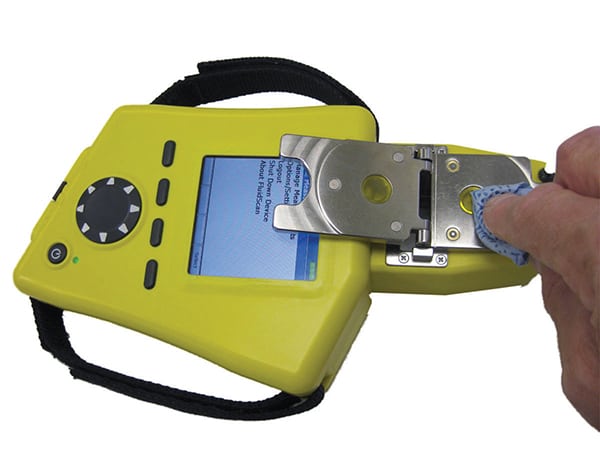 |
| 1. FluidScan Q1000. The handheld infrared spectrometer measures oil absorbance. Courtesy: Spectro Scientific |
FluidScan is widely used in laboratories as a titration alternative, in fleet management for mining trucks, in marine vessels, in power generation plants, and in industrial plants for oil condition-based predictive maintenance. The patented flip top cell uses three drops of oil, takes one minute, and does not require any chemicals or solvents to clean. The tool also has an onboard database with asset information and preset alarm limits utilizing a traffic light system (Figure 2). As a result, maintenance engineers can make immediate decisions right after the measurement.
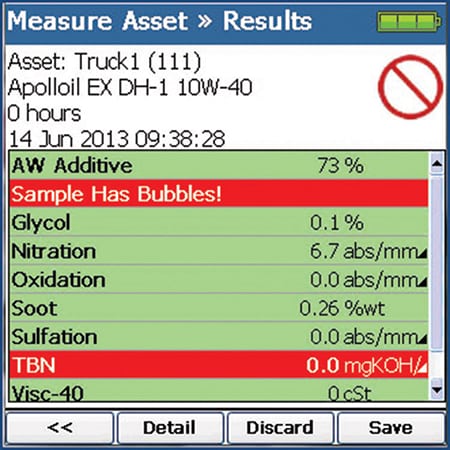 |
| 2. Danger! Results are flagged using a color-coded system that alerts users to out-of-specification conditions. Courtesy: Spectro Scientific |
The Q3050 portable kinematic viscometer (Figure 3) is a battery-powered tool that measures oil viscosity at a controlled temperature (40C). It can extrapolate viscosity at 100C based on a preset viscosity index of a given oil. The patented split cell (Figure 4) uses only two drops of oil—60 microliters (µL)—takes a couple of minutes to test, and does not require any chemicals or solvents to clean. The result is accurate within 3%—enough to make informed maintenance decisions. It is a good companion to the FluidScan Q1000 and is widely used in marine vessel and mining truck settings.
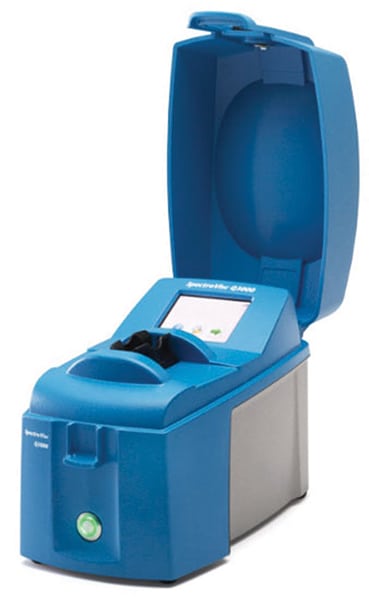 |
| 3. Q3050 kinematic viscometer. This portable tool quickly and accurately measures oil viscosity. Courtesy: Spectro Scientific |
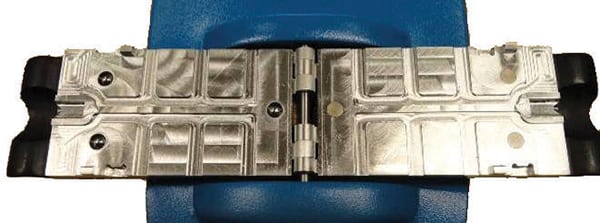 |
| 4. The split cell opens for easy cleaning. No chemicals or solvents are needed to prepare the cell for its next use. Courtesy: Spectro Scientific |
The Q6000 portable fuel dilution meter (FDM, Figure 5) is a new member of the oil condition family. Its predecessor was the FDM Q600, a stationary analyzer used in analytical labs and on-site labs to screen for fuel dilution in engine oil. It was jointly developed with the U.S. Navy and is widely used in mining, railway, and marine environments.
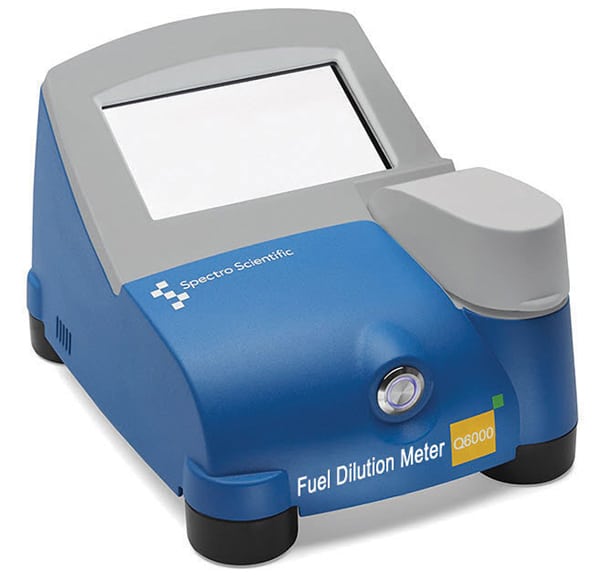 |
| 5. Q6000 fuel dilution meter. The analyzer measures the concentration of fuel vapor in the headspace of a sample to determine contamination levels in oil. Courtesy: Spectro Scientific |
The measurement is based on a calibrated response of a surface acoustic wave (SAW) sensor to a fuel vapor aromatic in the sample bottle headspace, which is proportional to the fuel content in the engine oil sample. The new FDM inherited the SAW sensing technique, but it is smaller and battery operated. The patent-pending sampling system makes it easier to use in the field and requires only 500µL of used oil.
The three tools complement each other and present a complete set of oil condition information. Each one is:
■ Small, light, portable, and battery operated
■ Efficient, using small volumes of oil (<1 milliliter combined)
■ Easy to clean, requiring no chemicals or solvent
■ Fast (1 to 2 minutes each)
■ Accurate (correlates to laboratory results)
■ Easy to use
This set of characteristics is what makes the maintenance professional’s life easier. Using these tools, it is possible to perform oil analysis at the generator and make immediate and accurate decisions with confidence. Engine generator fleet managers can implement a condition-based oil change practice, lowering operating expenses and reducing maintenance costs.
—Yuegang Zhao is vice president of sales and Dan Walsh is director of product management for Spectro Scientific.